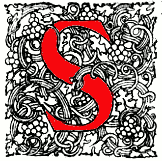
 amuel
Luke Fildes, who was born in Liverpool in 1844, was adopted by his paternal grandmother,
the political activist Mary Fildes. A leading figure in the
Chartist Movement of the 1840s, she
was one of the speakers at the Manchester meeting that led to the
Peterloo Massacre in 1819. The
strong appeal in Fildes's paintings to the emerging Victorian social consciousness may
be traced to the influence of his grandmother, publican of the Shrewsbury Arms in
Chester. In his first published illustration, created for the first edition of the
London Graphic, whose
staff he joined in 1869, Fildes executed the grim, socially realistic engraving
Houseless and
Hungry, intended to draw the attention of the prosperous middle class to the
continuing plight of those forced to take shelter for the night in the casual ward of the
workhouse. Accompanying an article on
the new Houseless Poor Act, the picture shows a line of homeless waiting to apply for
tickets that will grant them temporary entrance to the workhouse. At this time, he was
commissioned to provide the illustrations for the English translation of Victor Hugo's
L'Homme qui rit.
amuel
Luke Fildes, who was born in Liverpool in 1844, was adopted by his paternal grandmother,
the political activist Mary Fildes. A leading figure in the
Chartist Movement of the 1840s, she
was one of the speakers at the Manchester meeting that led to the
Peterloo Massacre in 1819. The
strong appeal in Fildes's paintings to the emerging Victorian social consciousness may
be traced to the influence of his grandmother, publican of the Shrewsbury Arms in
Chester. In his first published illustration, created for the first edition of the
London Graphic, whose
staff he joined in 1869, Fildes executed the grim, socially realistic engraving
Houseless and
Hungry, intended to draw the attention of the prosperous middle class to the
continuing plight of those forced to take shelter for the night in the casual ward of the
workhouse. Accompanying an article on
the new Houseless Poor Act, the picture shows a line of homeless waiting to apply for
tickets that will grant them temporary entrance to the workhouse. At this time, he was
commissioned to provide the illustrations for the English translation of Victor Hugo's
L'Homme qui rit.
Meantime, Charles Dickens was in desperate want of a new illustrator in November 1869, with only four months of Chapman and Hall's serial publication of The Mystery of Edwin Drood. Dickens enlisted the aid of both John Everett Millais and William Powell Frith (1819-1909) to find him a new illustrator. The result was, as we have seen above, Millais's recommending former Royal Academy student Luke Fildes, whose work to the Pre-Raphaelite "seemed to combine the aesthetic ideals of the new school of black-and-white illustrators and the social consciousness of the older generation" (Cohen 221), that is, Cruikshank, Seymour, and Hablot Knight Browne. At the novelist's request, Fildes provided Dickens with specimen drawings of Little Em'ly and Peggotty (from David Copperfield) to demonstrate his ability to draw pretty heroines. When he discussed them with Dickens, he was hired on the spot.
The painter of The Doctor [1874], now Sir Luke Fildes, exhibited a very beautiful portrait of his wife, which established him as a portrait painter at once, and it is unnecessary to say how many fine portraits he has since painted. [as of 1915: Ward, 145]

By the end of the 1870s, Fildes was sufficiently well established that he was able to give up book illustration entirely and devote himself to oil painting, having been elected to the Royal Academy of Art in 1877. To the end of his life, however, he was hounded by avid "Droodians" because they remained convinced that Dickens had revealed to the artist more about the outcome of the mystery than the artist had disclosed. Fildes, like Hubert von Herkomer and Frank Holl (fellow students at the South Kensington School of Art in the early 1860s), was influenced by the genre painting of Frederick Walker (1840-75), who had also illustrated Dickens's novels; Fildes is also often associated with the academic painting of John Everett Millais and William Powell Frith, the very artists who had recommended him to Dickens. His most celebrated painting in this vein is Applicants to a Casual Ward (1874), The Widower (1876), and The Return of the Penitent (1876). During the 1880s Fildes shifted to the highly lucrative field of portraiture. By the turn of the century, Fildes was acknowledged to be one of the best-paid portrait artists in Britain, having painted such celebrities as Sir Cecil Rhodes and several members of the royal family. In 1890, however, when Sir Henry Tate offered him £3,000 to provide something in the old vein for the new National Gallery of Art, Fildes produced The Doctor, inspired by the death of his own son. The celebrated work, which depicts a pensive physician watching a gravely ill child, was much praised by contemporary critics and went on to become one of the best selling engravings of the period. Knighted in 1906 by King Edward VII, whom he had painted, Fildes was made KCVO (Knight Commander of the Victorian Order) the year prior to the outbreak of the Great War.
Related Materials
Bibliography
Cohen, Jane R. "Chapter 18: Luke Fildes." Charles Dickens and His Original Illustrators. Columbus: Ohio State U. P., 1980. Pp. 221-234.
Milligan, Barry. "Luke Fildes's The Doctor, Narrative Painting, and the Selfless Professional Ideal." Victorian Literature and Culture. Vol. 44, Issue 3: 641-668. Cambridge: Cambridge U. P., 20 August 2016.
Mitchell, Sally, ed. Victorian Britain: An Encyclopedia. London and New York: Garland, 1988.
Schlicke, Paul, ed. Oxford Reader's Companion to Dickens. Oxford: Oxford Up. P., 1999.
Simkin, John. "Fildes, Luke." Spartacus Educational. Accessed 16 July 2023.
Tomlin, E. W. F. "The Illustrators." Charles Dickens 1812-1870: A Centenary Volume. London: Weidenfeld and Nicolson, 1969.
Ward, Leslie. Forty Years of 'Spy'. London: Chatto and Windus, 1915.
Created 13 April 2005 Last modified 18 July 2023